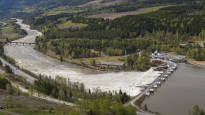The melting of glaciers has accelerated in Norway, and at least 20 glaciers have melted completely in recent years. Most of the lost glaciers were located in Northern Norway in the county of Nordland.
Also on the Lyngen peninsula, about 50 kilometers from the Finnish border, two small glaciers have melted, according to a report by the Norwegian Water and Energy Agency, NVE.
The melting of large glaciers will bring big changes to energy production in Norway. Almost all of the country’s energy is produced by hydropower plants, and about a fifth of it is connected to glaciers, says a professor and glacier researcher at the Department of Geography at the University of Bergen. Jostein Bakke.
According to Bakke, in the future, meltwater from the largest glaciers may carve tunnels inside the glaciers and end up on routes along which the waters go past storage basins and power plants.
– Inside the glacier, the water follows the surface of the ice and can also go uphill. Meltwater can form huge lakes. For example, in the Folgefonna area, a lake hundreds of meters deep and five kilometers long is forming, Bakke says.
The Folgefonna glacier is located in southern Norway, about 50 kilometers from the city of Bergen.
According to Bakke, adapting to the change in meltwater routes may require large investments and construction projects. Timing the change is difficult, according to Bakke.
– The speed of change depends on what kind of emission path the world chooses. It is very difficult to say what will happen in the next 50 years, says Bakke.
Hydropower systems for national parks?
A large part of Norwegian glaciers have been defined as national parks. Existing storage basins, canals and hydroelectric plants are outside these areas.
According to Jostein Bakke, in the future, as a result of the melting, the melting water basins of the glaciers may rise higher in the mountains, inside the borders of the national parks.
– The glaciers are in the most beautiful places in Norway. Norwegians are facing a political debate about whether to start building hydropower systems in national parks.
According to Bakke, the new meltwater lakes provide new opportunities because the water flowing from higher up can produce more energy than before.
– Energy production volumes may even increase.
Farewell to small valley glaciers
The melting of glaciers is monitored by companies that produce hydropower. Statkraft, owned by the Norwegian state, tries to prepare for future changes even now, even though from the perspective of the energy company, the change is slow.
– When we plan and carry out renovations of power plants, we estimate how much water will be produced in, for example, 50 years from now, says the company’s expert Gaute Lappegard.
According to Lappegard, the changes caused by melting vary depending on the size of the glacier.
– The small valley glaciers will probably be gone by the 21st century. They are already located in the valleys, so it is easy to predict the change in the amount of water.
The situation is different for the largest Norwegian glaciers, because the valleys under the glacier can change the routes of the meltwater.
According to Lappegard, a key tool for the company is the meteorological models that predict the future climate.
– Rainfall may increase in the area of some power plants. In other areas, rising temperatures accelerate the evaporation of water from storage tanks, Lappegard says.
Glacial floods are already a threat
The storage basins of some Norwegian hydropower plants may be vulnerable to glacial river floods, Jostein Bakke estimates.
– The possibility of destruction is huge and the probability of flooding is increasing.
A glacial river flood occurs when the melting water of the glacier carves a basin in the glacier, the lower edge of which breaks.
– As a society, we strive to regulate nature. In the future, we have to discuss how much money we want to spend on managing the consequences of climate change. In the end, however, you cannot control all the consequences, says Bakke.
According to Bakke, the Norwegian water and energy authority NVE tries to monitor as precisely as possible where new meltwater pools are formed, but the work is difficult.
In terms of hydropower production, the regulation of electricity production based on storage reservoirs is, according to Bakke, central to promoting the European green transition. The largest storage basins are in southern Norway, which also has the highest mountain ranges and the largest glaciers.
According to Statkraft expert Gaute Lappegard, a glacial river flood can release an amount of water equivalent to several months’ water accumulation at once.
– The water masses are huge and the floods can be dramatic. Bottom sediment and even large boulders are carried along with the water. When they end up in storage pools, the volume of the pools decreases. At worst, they can also block channels.
The effects of melting glaciers are discussed in this episode of the Age of Heat series:
The effects of climate change on the energy industry are discussed in this episode of the Climate changers series:
